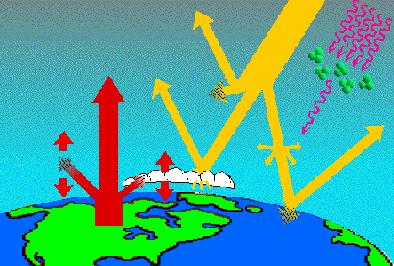All objects emit radiation. The intensity and characteristic wavelength of that emitted radiation depend on the object's temperature. Radiative intensity increases, and the dominant wavelength decreases, with increasing temperature of the emitting surface. Owing to this relationship, the distribution of wavelengths (or spectrum) emitted by the sun, and that of the earth-atmosphere system are virtually distinct. Nearly all of the sun's radiant energy is in the waveband encompassing the ultra-violet, visible, and near infrared (280 to 2800 nm), or short wavelengths; and emissions from the earth and atmosphere are confined to longer wavelengths in the thermal infrared (4000 and 100000 nm). These wavebands represent the primary energy sources and sinks of the earth-atmosphere system.
The solar irradiance intercepted by the earth at the top of the atmosphere, the mean solar constant, is quite stable with an observed mean value of 1365 W/m2 ± 0.3%. Although, according to the newest measurements from the SORCE satellite, that value is most likely closer to 1360.8 W/m2 ± 0.3%. Of course, when considering the elliptical orbit of the earth the actual solar constant varies systematically throughout the year. It is about 0.97 times the mean value at aphelion (northern hemisphere summer solstice), and 1.03 times the mean value at perihelion (northern hemisphere winter solstice). At the equinoxes, the solar constant is around the mean value. In the mean, only about half of this energy reaches the surface and is available to drive surface and biological processes. Of the other half, approximately 30% is reflected back to space, and the remaining 20% is absorbed by clouds, dust, and “greenhouse” gasses such as water vapor, carbon dioxide, and ozone.

Solar radiation reaching the surface is made up of two components, direct and diffuse. Direct radiation is that which travels unimpeded through space and the atmosphere to the surface; and diffuse radiation is that scattered by atmospheric constituents such as molecules, aerosols, and clouds. In simple terms, direct radiation causes shadows, and diffuse is responsible for sky light. The sum of the direct and diffuse components reaching a horizontal surface is global radiation.
In moist, cloudy regions, much of the thermal infrared radiation emitted by the surface of the earth is absorbed by clouds, water vapor, and "greenhouse" gasses such as carbon dioxide. Under the clouds, a large fraction of the absorbed radiation is emitted back to the surface, keeping it relatively warm. However, a significant amount of thermal energy is lost to space from upward emissions by cloud tops, greenhouse gasses, and from the surface in dry, cloud-free regions. Thus thermal emission is responsible for a net loss of energy from the earth and atmosphere.

Because of the earth's rotation, curvature, variable cloud cover, and other factors, the contributions of solar and thermal infrared radiation to the earth's energy budget varies greatly over the globe, and over annual and diurnal cycles. Though, in the mean, over long periods, the earth-atmosphere system is in net radiative balance. Also, the general circulation of the earth and weather systems act to counter imbalances created by differential radiative input by the net transport of equatorial heat poleward and polar cold air equatorward. Owing to this equilibrium, the earth maintains a nearly constant mean temperature, greater than what would be experienced if there were no atmosphere, and it is that which creates an hospitable environment for life.
Changes in the concentrations of cloud cover, carbon dioxide, water vapor, or dust will alter the earth's radiation balance, and may ultimately lead to climate change. This is why long-term monitoring of surface radiation is very important.
